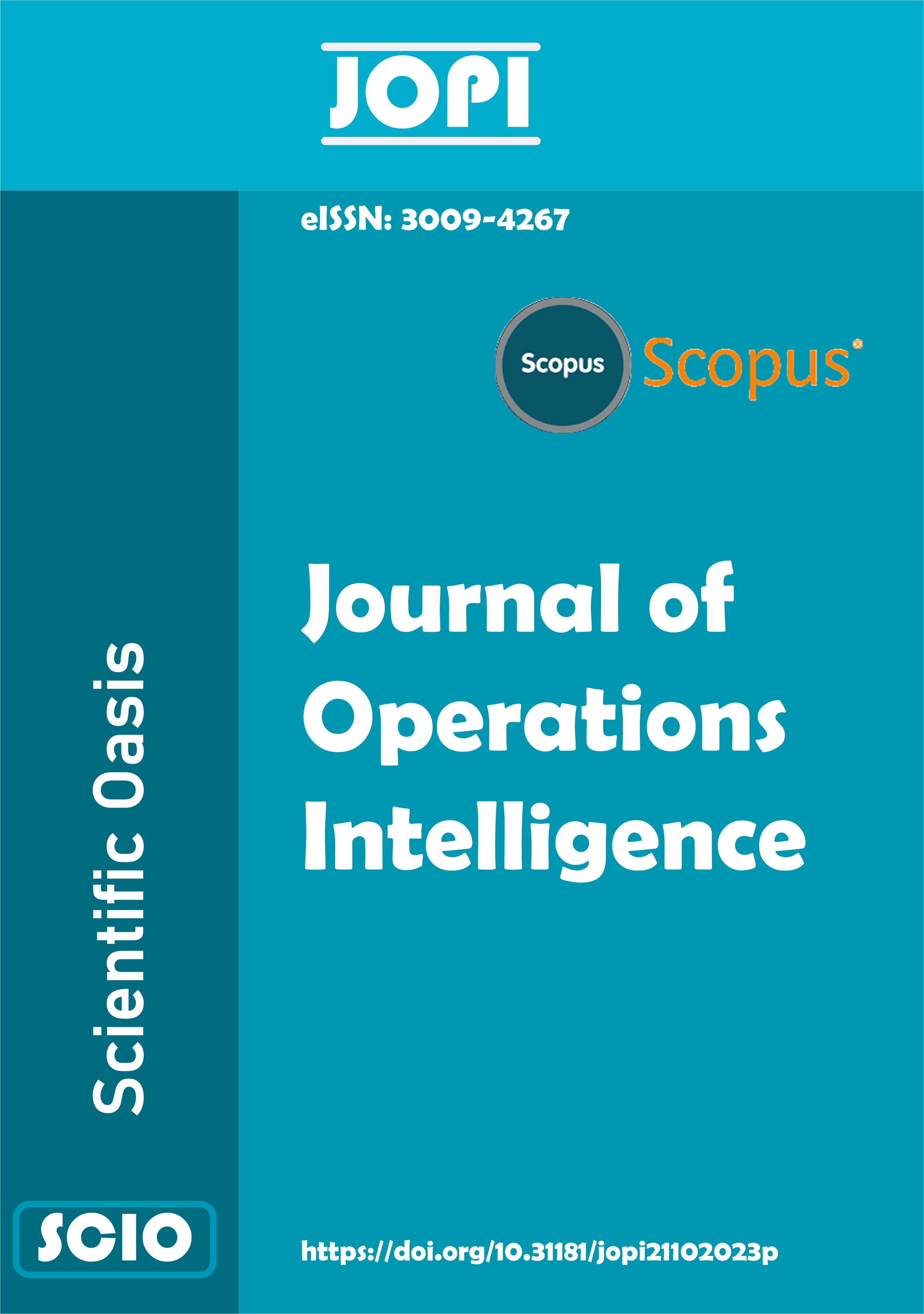Measurement Method for Food Supply Chain Security Level from the Perspective of Resilience
DOI:
https://doi.org/10.31181/jopi31202557Keywords:
Food Supply Chain Resilience, MCDM, Fuzzy set, MABACAbstract
The resilience of China's food supply chain is of significant importance for ensuring national food security and maintaining social stability, and there is a close connection between supply chain resilience and safety levels, which can be considered integrated to some extent. To quantitatively measure the safety level of the food supply chain, this study explores the measurement of food supply chain safety based on an improved MABAC model. First, content mining is used to collect and analyze literature, identifying resilience risk factors and relevant evaluation indicators in the food supply chain. Second, T-spherical fuzzy sets are employed to convert expert evaluation language, and expert weights are determined through score functions to establish a weighted evaluation matrix. Finally, the entropy method is used to calculate indicator weights, combined with the MABAC method for risk ranking to derive the final results. The findings indicate that emergencies, the economy, and the market are the primary risk factors affecting the resilience of the food supply chain. The conclusion emphasizes the need to focus on controlling emergencies, guiding economic and market development directions, preparing risk prevention plans in advance, reducing the probability of unexpected events and their severity, and enhancing supply chain resilience and safety levels.
Downloads
References
Zhan, L., Jiang, H. P., & Jiang, L. (2024). Management trade-offs and synergies in strengthening the resilience of China's food supply chain. China Business and Market (In Chinese), 38(11), 26–37.
de Gorter, H., Drabik, D., Just, D. R., et al. (2021). Analyzing the economics of food loss and waste reductions in a food supply chain. Food Policy, 98, 101953. https://doi.org/10.1016/j.foodpol.2020.101953
Han, J. (2024). Reshaping the grain supply chain in the digital era and China's food security. Journal of Southwest University of Science and Technology (Philosophy and Social Sciences Edition) (In Chinese), 41(4), 43–52.
Dong, C., & Wang, Z. (2021). Research on grain supply chain based on supply chain control tower. Economic Management Digest (In Chinese), 23, 168–170.
Yin, G. (2022). Research on influencing factors of grain supply chain construction: A case study of Henan Province. Heilongjiang Grain (In Chinese), 7, 49–51.
Hu, Y., & Huang, H. (2023). Research on supply chain risk management of multinational enterprises in the post-emergency context. Hebei Enterprise (In Chinese), 3, 69–71.
Ding, C., & Xu, X. (2022). Research on security risks and countermeasures of international grain supply chains. Economist (In Chinese), 6, 109–118.
Shishodia, A., Sharma, R., Rajesh, R., & et al. (2023). Supply chain resilience: A review, conceptual framework and future research. The International Journal of Logistics Management, 34(4), 879–908. https://doi.org/10.1108/IJLM-03-2021-0169
Nie, Y., Zheng, J., & Ma, X. (2024). Resilience analysis of China's industrial and supply chains using the CoDEA method: An empirical study based on input-output tables. Logistics Research (In Chinese), 6, 24–35.
Zhang, Y. (2024). The impact of digital economy development on retail supply chain resilience from the perspective of industrial chain digitalization. Journal of Commercial Economics (In Chinese), 22, 10–14.
Zamani, E. D., Smyth, C., Gupta, S., & et al. (2023). Artificial intelligence and big data analytics for supply chain resilience: A systematic literature review. Annals of Operations Research, 327(2), 605–632. https://doi.org/10.1007/s10479-022-04983-y
Ren, G., Jing, M., & Wang, L. (2024). Institutional advantages and path selection of state-owned enterprises' digital transformation in enhancing industrial chain resilience. Jiangsu Social Sciences (In Chinese), 6, 76–84.
Zeng, X. (2023). Enhancing the resilience and security level of industrial and supply chains in high-quality development. Ningxia Social Sciences (In Chinese), 2, 101–107.
Shi, J., & Lu, D. (2023). Research on efforts to enhance the resilience and security level of industrial and supply chains. Research on Financial and Economic Issues (In Chinese), 2, 3–13.
Guo, C., & Xu, T. (2023). Research on the resilience and security level of China's pharmaceutical industrial and supply chains. Economy and Management (In Chinese), 37(3), 82–93.
Li, Q., Cao, E., & Peng, C. (2023). Research progress on change design of product and supply chain co-evolution systems. Control Theory & Applications (In Chinese), 40(2), 331–342.
Ivanov, D., & Dolgui, A. (2021). A digital supply chain twin for managing the disruption risks and resilience in the era of Industry 4.0. Production Planning & Control, 32(9), 775–788. https://doi.org/10.1080/09537287.2020.1768450
Ozdemir, D., Sharma, M., Dhir, A., et al. (2022). Supply chain resilience during the COVID-19 pandemic. Technology in Society, 68, 101847. https://doi.org/10.1016/j.techsoc.2021.101847
Pamučar, D., & Ćirović, G. (2015). The selection of transport and handling resources in logistics centers using Multi-Attributive Border Approximation area Comparison (MABAC). Expert Systems with Applications, 42(6), 3016–3028. https://doi.org/10.1016/j.eswa.2014.11.057
Chattopadhyay, R., Das, P. P., & Chakraborty, S. (2022). Development of a rough-MABAC-DoE-based metamodel for supplier selection in an iron and steel industry. Operational Research in Engineering Sciences: Theory and Applications, 5(1), 20–40. https://doi.org/10.31181/oresta190222046c
Đoković, L., & Doljanica, D. (2023). Application of AHP and MABAC methods in the framework of multi-criteria decision-making in the selection of investment projects. Journal of Process Management and New Technologies, 11(3–4), 105–114. https://doi.org/10.5937/jpmnt11-47800
Chen, Z., Wu, D., Luo, W., et al. (2024). A hybrid heterogeneous framework for medical waste disposal evaluation by fusing group BWM and regret-rejoice MABAC. Expert Systems with Applications, 249. https://doi.org/10.1016/j.eswa.2024.123514
Liu, P., & Zhang, P. (2021). A normal wiggly hesitant fuzzy MABAC method based on CCSD and prospect theory for multiple attribute decision making. International Journal of Intelligent Systems, 36(1), 447–477. https://doi.org/10.1002/int.22306
Büyüközkan, G., Mukul, E., & Kongar, E. (2021). Health tourism strategy selection via SWOT analysis and integrated hesitant fuzzy linguistic AHP-MABAC approach. Socio-Economic Planning Sciences, 74, 100929. https://doi.org/10.1016/j.seps.2020.100929
Pamučar, D., Puška, A., Stević, Ž., et al. (2021). A new intelligent MCDM model for HCW management: The integrated BWM–MABAC model based on D numbers. Expert Systems with Applications, 175. https://doi.org/10.1016/j.eswa.2021.114862
Yang, G. (2025). Enhanced IVIFN–ExpTODIM–MABAC technique for multi-attribute group decision-making and applications to college English teaching quality evaluation under interval-valued intuitionistic fuzzy sets. International Journal of Fuzzy Systems. Advance online publication. https://doi.org/10.1007/s40815-024-01876-z
Deveci, M., Erdogan, N., Cali, U., et al. (2021). Type-2 neutrosophic number based multi-attributive border approximation area comparison (MABAC) approach for offshore wind farm site selection in USA. Engineering Applications of Artificial Intelligence, 103, 104311. https://doi.org/10.1016/j.engappai.2021.104311
Tan, J., Liu, Y., Senapati, T., et al. (2023). An extended MABAC method based on prospect theory with unknown weight information under Fermatean fuzzy environment for risk investment assessment in B&R. Journal of Ambient Intelligence and Humanized Computing, 14(10), 13067–13096. https://doi.org/10.1007/s12652-022-03769-1
Downloads
Published
Issue
Section
License
Copyright (c) 2025 Yan Shi, Xinyue Yu, Chuansen Shen (Author)

This work is licensed under a Creative Commons Attribution 4.0 International License.





















